Mazda
 From Nwe
From Nwe | Mazda Motor Corporation Matsuda Kabushiki-gaisha マツダ株式会社 |
|
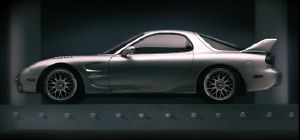
|
|
| Type | Public (TYO: 7261) Associate company of Ford Motor Company (33.6% ownership & controlling interest, unconsolidated)[1] |
|---|---|
| Founded | 1920 |
| Headquarters | |
| Key people | Jujiro Matsuda (founder) Kazuhide Watanabe (Chairman) Hisakazu Imaki (CEO) |
| Industry | Automotive |
| Revenue | |
| Net income | |
| Employees | 39,364 (as of March 31, 2008, consolidated) |
| Website | Mazda Global Web Site |
Mazda Motor Corporation (マツダ株式会社 Matsuda Kabushiki-gaisha) (TYO: 7261) is a Japanese automotive manufacturer based in Hiroshima, Japan. Mazda began in 1920 as Toyo Cork Kogyo Co., Ltd.(東洋コルク工業株式会社, Tōyō Koruku Kōgyō Kabushiki Gaisha). In 1931, the company introduced the first "Mazdago" (or TCS), a three-wheeled open "truck" that resembled a motorcycle with an open wagon or truck bed. The Mazda R360, a two-door, two-seat coupe introduced in 1960, was Mazda's first real car. In the 1960s, Mazda developed the Wankel rotary engine as a way of differentiating itself from other Japanese auto makers. Mazda experienced a decline after the 1973 fuel crisis, when customers abandoned rotary engines in favor of more fuel-efficient piston engines. In 1979, Ford Motor Company acquired a 27 percent financial stake in Toyo Kogyo and the two companies began to collaborate on a number of projects, particularly pick-up trucks and small cars. The company changed its name to Mazda Motor Corporation in 1984.
During 2007, Mazda produced almost 1.3 million vehicles for sale worldwide; nearly one million of these were produced in the company's Japanese plants.[3] Mazda has experienced substantial success in automobile racing with both its signature Wankel-engine cars and its piston-engine models. Mazda vehicles and engines compete in a wide variety of disciplines and series around the world. Mazda developed a hydrogen rotary engine and was the first company in the world to begin commercial leasing of a car that can run on hydrogen fuel.[4] Like many automakers, Mazda is striving to increase recycling and to incorporate environmentally-friendly components made of bioplastics and bio-fabrics.
Name
It is said that Mazda coincides with the anglicized pronunciation of the founder's name, Jujiro Matsuda, who was interested in spirituality, and chose to rename the firm in honor of both his family and Zoroastrianism.[5] The word Mazda derives from Ahura Mazda, the Avestan language name for a divinity exalted by the ancient Iranian prophet Zoroaster, as the source of wisdom, intelligence, and harmony.
In Japanese, the company's name has always been pronounced and spelled as "Matsuda," the name of the founder. Television ads for Mazda automobiles in the United States use a pronunciation where the initial vowel sound is similar to the word "art," while Canadian Mazda advertisements pronounce the company's name with the initial "a" sound of the word "has." The initial vowel sounds (in the American and Canadian advertisements) are references to the first and last A sounds in the original Persian pronunciation.
History
Early days
Jujiro Matsuda the founder of Mazda, was born August 8, 1875, in Hiroshima, the son of a fisherman. At the age of fourteen he was apprenticed to a blacksmith in [[Osaka], and in 1906, he invented the "Matsuda-type pump." Later, he took over management of the foundry at which he had been apprenticed and changed its name to "Matsuda Pump Partnership." He was forced out of his company, but soon afterward he started an armament manufacturer named Matsuda Works. The company prospered when it was commissioned as a supplier to the Tsar of Russia[6] and manufactured the Type 99 rifle for the Japanese military.
Toyo Kogyo and Mazda
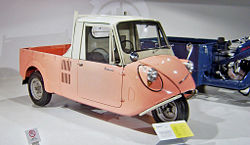
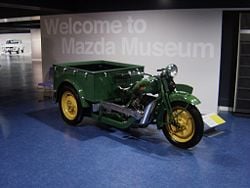
By 1921, Jujiro Matsuda was a wealthy man. He moved back to Hiroshima where he was asked to take over management of floundering artificial cork manufacturer Toyo Cork Kogyo Co., Ltd. (東洋コルク工業株式会社 Tōyō Koruku Kōgyō Kabushiki Gaisha), founded in 1920, which had been placed into receivership by its creditors when the market for artificial cork dried up following the end of World War I.[6] The unprofitable cork business was stopped, and Matsuda focused on tool manufacturing. Toyo Cork Kogyo renamed itself to Toyo Kogyo Co., Ltd. (東洋工業株式会社, Tōyō Kōgyō Kabushiki Gaisha) in 1927. In 1931, the company oversaw the introduction of the "Mazdago" (or TCS), a three-wheeled open "truck" that resembled a motorcycle with an open wagon or truck bed. It was steered with handlebars and powered with an air-cooled 1-cylinder engine/transmission combination unit. It was manufactured in what is now Fuchū city.
Toyo Kogyo produced weapons for the Japanese military throughout the Second World War, most notably the series 30 through 35 Type 99 rifle. The Toyo Kogyo headquarters were heavily damaged on August 6, 1945 during the bombing of Hiroshima. The Fuchū city plant, 5.3 kilometers from the site of the explosion, was left relatively unscathed and Matsuda offered its use for the Hiroshima bureau of NHK (Japan Broadcasting Corporation).
Matsuda was not accused of being a war conspirator, and a revitalized Toyo Kogyo was the main force behind repairing the damaged economy of Hiroshima following World War II. In 1950, Toyo Kogyo supported the startup of a baseball team, the Hiroshima Carp.
Manufacture of automobiles
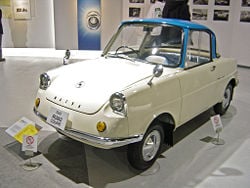
Matsuda died on March 9, 1952. His adopted son-in-law, Tsuneji Matsuda succeeded him as president of Toyo Kogyo, and oversaw the expansion of its automobile division until 1979.
In 1984, the company formally adopted the Mazda name, though every automobile sold from the beginning bore that name. The Mazda R360, introduced in 1960, was Mazda's first real car—a two-door, two-seat coupe. It featured a short 69 inch (1753 mm) wheelbase and weighed just 838 lb (380 kg). It was powered by a rear-mounted air-cooled 356 cc V-twin engine and was capable of speeds of about 52 mph (84 km/h). It had a 4-speed manual or two-speed automatic transmission. The suspension, front and rear, was rubber "springs" and torsion bars. The R360 was replaced in 1961 with the Mazda P360 Carol, the company's first 4-passenger car. It was larger than the Mazda R360, with a 193 cm wheelbase and a total length of 298 cm. It used a rear-mounted water-cooled 358 cc 4-cylinder OHV engine, one of the smallest 4-cylinder automobile engines in history (only Honda's 356 cc DOHC alloy 4-cylinder unit used in the T360 truck, was smaller). A convertible version appeared in 1964; production of the R360 lasted for six years.
Within a few years of introducing the R360, Mazda had captured much of the lightweight (keicar) market in Japan.
Wankel rotary engine
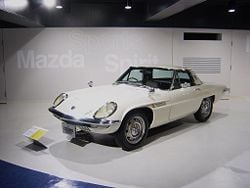
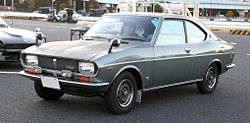
In the 1960s, Mazda began a major engineering effort to develop the Wankel rotary engine as a way of differentiating itself from other Japanese auto makers. From the first limited-production Cosmo Sport in 1967 until the present RX-8, Mazda has become the sole manufacturer of Wankel-type engines mainly through attrition (NSU and Citroën both gave up on the design during the 1970s, and prototype efforts by General Motors never made it to production).
Mazda rapidly began to export its vehicles. Both piston-powered and rotary-powered models made their way around the world, but the rotary models quickly became popular for their combination of power and light weight when compared to similarly-powered heavy V6 or V8 piston-engines. The R100 and the famed RX series (RX-2, RX-3, and RX-4) were the company's major exports.
In 1970, Mazda formally entered the North American market (as Mazda North American Operations) and was very successful there. The Mazda Rotary Pickup (based on the conventional piston-powered B-Series model) was created solely for North American buyers. To this day, Mazda remains the only automaker to have produced a Wankel-powered pickup truck, a rotary-powered bus (the Mazda Parkway, offered only in Japan) or station wagon (within the RX-3 line).
Mazda's success with rotary engines continued until the onset of the 1973 oil crisis. As American buyers (as well as those in other nations) turned to vehicles with better fuel efficiency, the rotary-powered models began to fall out of favor. The company continued to produce a variety of four-cylinder piston-engine models throughout the 1970s. The smaller Familia line became particularly important to Mazda's worldwide sales after 1973, along with the somewhat larger Capella series.
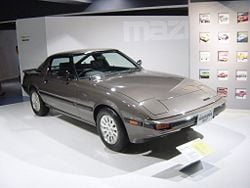
Not wishing to abandon the rotary engine entirely, Mazda refocused its efforts and used it in sports car designs, starting with the lightweight RX-7 in 1978 and continuing with the modern RX-8. This focus on sports cars resulted in the development of the lightweight piston-powered Mazda Roadster (perhaps better known by its worldwide names as the MX-5, or Miata), inspired by the concept jinba ittai (人馬一体, rider (jin) and horse (ba) as one (ittai) in battle). Introduced in 1989, the Roadster has been widely credited with reviving the concept of the small sports car after its decline in the late 1970s.
Alliance with Ford
Mazda experienced financial turmoil and decline during the 1970s. In 1979, Ford Motor Company acquired a 27 percent financial stake in Toyo Kogyo. The alliance with Ford led to the divesture of shares by the Matsuda family and the change of Toyo Kogyo into Mazda Motor Corporation in 1984. The Matsuda family still owns a controlling interest in the Hiroshima Toyo Carp.
During the 1980s, Ford acquired an additional 20 percent stake in Mazda. The two companies collaborated on a number of projects, particularly pickup trucks (like the Mazda B-Series, which spawned a Ford Courier variant in North America) and smaller cars. Mazda's Familia platform was used for Ford models like the Laser and Escort, while the Capella architecture found its way into Ford's Telstar sedan and Probe sports models.
The Probe was built in a new Mazda assembly plant in Flat Rock, Michigan along with the mainstream 626 sedan (the North American version of the Capella) and a companion Mazda MX-6 sports coupe. (The plant is now a Ford-Mazda joint venture known as AutoAlliance International.) Ford has also loaned Mazda some of their capacity when needed: The Mazda 121 sold in Europe was, for a time, a variant of the Ford Fiesta built in plants throughout that continent. Mazda has also made an effort in the past to sell some Ford cars in Japan, mainly through its Autorama dealer group.
Mazda also helped Ford develop the 1991 Explorer, which Mazda sold as the 2-door Mazda Navajo from 1991 through 1994. Ironically, Mazda's version was unsuccessful, while the Ford (available from the start as a 4-door or 2-door model) instantly became the best selling sport-utility vehicle in the United States and kept that title for over a decade. Beginning in 1994, Mazda used Ford's Ranger pickup as the basis for its North American-market B-Series trucks.
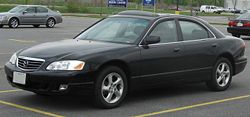
Pursuing its interest in alternative engine technology, Mazda introduced the first Miller cycle engine for automotive use in the Millenia luxury sedan of 1995. Though the Millenia (and its Miller-type V6 engine) were discontinued in 2002, the company has recently introduced a much smaller Miller-cycle four-cylinder engine for use in their Demio starting in 2008.
Financial turn-around
Further financial difficulties at Mazda during the 1990s (partly due to the 1997 Asian financial crisis) led Ford to increase its stake in Mazda to a 33.9 percent controlling interest on March 31, 1997. In 1997, Henry Wallace was appointed President and became the first foreign-born head of a Japanese car company. Wallace restructured Mazda and established a new strategic direction. The present Mazda logo was adopted; a new product plan was developed to achieve synergies with Ford; and Mazda's digital innovation program was initiated to speed up the development of new products. Mazda took more control of its overseas distributors and rationalized dealerships and manufacturing facilities to reduce costs and increase efficiency. These changes brought Mazda back into profitability. Ford executive Mark Fields, who took over as Mazda's CEO later, has been credited with expanding Mazda's new product lineup and leading the turnaround during the early 2000s. Since 2003, Mazda has had a Japanese-born CEO, Hisakazu Imaki.
Ford's deeper involvement in Mazda's operations resulted in an increasing level of cooperation in engineering and marketing. The two firms now share engine designs from around the world (Ford uses Mazda's four-cylinder designs in large numbers, while Mazda has replaced its own V6 engine lines with designs from Ford) and have made several combined efforts in platform engineering, starting with the Ford Escape and Mazda Tribute models, sold in many parts of the world. The most recent Ford Focus also shares a platform with both the Mazda Axela and the Volvo S40.
On November 19, 2008, Ford Motor Company reduced its holding in Mazda to 13 percent by selling almost US$540 million of Mazda stock to ease its own cash flow problems.[7]
Brand names
Mazda once used a number of different marques (brand names) in the Japanese (and occasionally Australian) market, including Autozam, Eunos, and Efini, which have since been phased out. This diversification put too much stress on the product development groups at Mazda; instead of having a half-dozen variations on any given platform, they had to work on dozens of different models and consumers were confused by the large number of similar new models. Today, the former brand names exist in Japan as sales channels (specialized dealerships) but no longer have specialized branded vehicles. For example, the Carol is sold at the Autozam store (which specializes in small cars), but it is sold with the Mazda marque, not as the Autozam Carol as it once was.
In early 1992, Mazda planned to release a luxury brand, "Amati," to challenge Acura, Infiniti, and Lexus in North America. The initial Amati range would have included the Amati 500 (which became the Eunos 800 in Japan and Australia, Mazda Millenia in the U.S., and Mazda Xedos 9 in Europe) and the Amati 1000 (a rear-wheel drive V12 successor to the Mazda 929). The Amati brand was eventually scrapped before any cars hit the market.
In Europe, the Xedos name was also associated with the Mazda Xedos 6; the two models were in production from 1992 until 1997. The Xedos line was marketed under the Mazda brand, and used the Mazda badge from the corresponding years.
Alternative propulsion and bio-car
Mazda has conducted research in hydrogen-powered vehicles for several decades. As a major step in this effort, the company plans to release a hydrogen-fueled hybrid car in 2008, the Premacy Hydrogen RE compact minivan. The prototype has so far proven capable of traveling up to 200 kilometers (120 miles).[8]
Mazda is developing a rival to the plug-in hybrid Chevrolet Volt; Mazda tests are sufficiently advanced that Mazda has a working prototype in a Mazda 5 MPV bodyshell The first stop-start Mazda will go on sale in Japan next year and the system is expected to be implemented globally on a variety of models.[9]
Mazda plans to introduce bioplastic internal consoles and bio-fabric seats made from plant materials in in its Mazda5 model in 2008. Up to 30 percent of the interior parts in the Mazda5 will be made of bio-material components [10].
Auto racing
Mazda has experienced substantial success in automobile racing with both its signature Wankel-engine cars (in two-rotor, three-rotor, and four-rotor forms) and its piston-engine models. Mazda vehicles and engines compete in a wide variety of disciplines and series around the world.
International competition
Mazda's competition debut was on October 20, 1968, when two Mazda Cosmo Sport 110S coupes entered the 84 hour Marathon de la Route ultra-endurance race at the Nürburgring, one finishing in fourth place and the other breaking an axle after 81 hours. The next year, Mazda raced Mazda Familia R100 M10A coupes. After winning the Singapore Grand Prix in April 1969 and coming in fifth and sixth in the Spa 24 Hours (beaten only by Porsche 911s), on October 19, 1969, Mazda again entered the 84 hour Nürburgring race with four Familias. Only one of these finished, taking fifth place.
In 1976, Ray Walle, owner of Z&W Mazda, drove a Cosmo (Mazda RX-5) from the dealership in Princeton, New Jersey, to Daytona, won the Touring Class Under 2.5 Liters at the 24 Hours of Daytona, and drove the car back to New Jersey. The Cosmo placed 18th overall in a field of 72. The only modifications were racing brake pads, exhaust, and safety equipment.
The Mazda RX-7 has won more IMSA races in its class than any other model of automobile, with its hundredth victory on September 2, 1990. Following that, the RX-7 won its class in the IMSA 24 Hours of Daytona race ten years in a row, starting in 1982. The RX-7 won the IMSA Grand Touring Under Two Liter (GTU) championship each year from 1980 through 1987, inclusive.
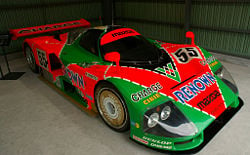
In 1991, a four-rotor Mazda 787B (2622 cc actual, rated by FIA formula at 4708 cc) won the 24 Hours of Le Mans auto race. The 787B remains the only car with a non-piston-engine ever to win at Le Mans, and Mazda is still the only team from outside Western Europe or the United States to have won at Le Mans. After the 1991 race, the winning engine was publicly dismantled for internal examination, which demonstrated that despite 24 hours of extremely hard use it had accumulated very little wear.
The Le Mans win in 1991 followed a decade of class wins from other Mazda prototypes, including the 757 and 767. The Sigma MC74 powered by a Mazda 12A engine was the first engine and team from outside Western Europe or the United States to finish the entire 24 hours of the Le Mans race, in 1974. Mazda is also the most reliable finisher at Le Mans (with the exception of Honda, who has entered only three cars in only one year), with 67 percent of its entries finishing the race. In 2006, the Mazda’s Courage C65 LMP2 car finished in 3rd place at the American Le Mans Series race at Road Atlanta. This prototype racer uses the Renesis Wankel from the RX-8.
Mazdas have also enjoyed substantial success in World Land Speed competition, SCCA competition, drag racing, pro rally competition (the Familia appeared in the WRC several times during the late '80s and early '90s), the One Lap of America race, and other venues. Wankel engines have been banned for some time from international Formula One racing, as well as from United States midget racing, after Gene Angelillo won the North East Midget Racing Association championship in 1985, with a car powered by a 13B engine and again in 1986, in a car powered by a 12A engine.
Spec series
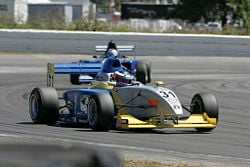
Formula Mazda Racing features open wheel race cars with Mazda engines, adaptable to both oval tracks and road courses, on several levels of competition. Since 1991, the professionally organized Star Mazda Series has been the most popular format for sponsors, spectators, and upward-bound drivers. The engines are all built by one engine builder, certified to produce the prescribed power, and sealed to discourage tampering. They are in a relatively mild state of racing tune, so that they are extremely reliable and can go years between motor rebuilds. Formula Mazda has its own class in SCCA club racing, and there is a professional series (officially the "Star Mazda Championship Presented by Goodyear") in North America that often runs as a support race for the American Le Mans Series. The cars are very popular; seeing a field of 40 or more cars at a race is quite common. Many drivers aspiring to the top classes of racing use the pro series to hone and demonstrate their talent. In terms of both cost and performance, Formula Mazda lies between Formula Ford and Formula Atlantic. A full season in the Pro series cost around $200,000-$300,000 in 2005.
Spec Miata has become one of the most popular and most affordable road racing classes in North America. The Spec Miata (SM) class is intended to provide the opportunity to compete in low cost, production-based cars with limited modifications, suitable for racing competition. The rules are intentionally designed to be more open than the Showroom Stock class but more restricted than the Improved Touring class.
Sponsorships
Mazda is a major sponsor to several professional sports teams, including:
- Hometown teams:
- Hiroshima Toyo Carp (Nippon Professional Baseball): The "Toyo" part of the team's name is in honor of Mazda's part-ownership of the team since 1968 (when Mazda was still known as Toyo Kogyo). The Matsuda family, descended from the founder of Mazda, holds the majority share in team ownership.
- Sanfrecce Hiroshima (J. League): Originally known as Toyo Kogyo Soccer Club and founded in 1938, it was owned directly by Mazda until 1992 when Mazda reduced its share to professionalize the club for the new J. League.
- Teams abroad:
- Fremantle Football Club (Australian Football League)
- North Melbourne Football Club (Australian Football League)
The company also sponsors various marathon and relay race events in Japan, such as the Hiroshima International Peace Marathon and the Hiroshima Prefectural Ekiden Race, along with numerous other sporting and charity endeavors in Hiroshima and Hofu.[11]
Mazda also maintains sponsorship of the Laguna Seca racing course in California, using it for its own automotive testing purposes as well as for the numerous racing events (including several Mazda-specific series) that it hosts.[12].
Marketing
Since 2000, Mazda has used the phrase "Zoom-Zoom" to describe what it calls the "emotion of motion" that it claims is inherent in its cars.[13] Successful in North America, the Zoom-Zoom campaign is now used around the world.[14]
Environmental and community record
Mazda has a documented commitment to conserving resources and protecting the environment. Since 1990 it has reduced waste material going into landfills in its production facilities by 55 percent, and its overall recycling rate topped 91 percent in 1996. Over 75 percent of Mazda plastic parts can be recycled. All gaskets and brake-pads are asbestos-free, and no ozone-damaging CFCs are used in polyurethane products such as the foam padding in seats, armrests and steering wheels. Many Mazda plants including all its operations in Japan, and AAT, a joint venture with Ford in Thailand, have passed the stringent ISO 14001 test, commonly known as the environmental ISO.[15] The Mazda Foundation contributes financial support to a number of charities that help to maintain a clean environment, preserve historic landmarks, foster youth literacy, enhance cross-cultural understanding and conduct medical research to find a cure for juvenile diabetes.[16]
Notes
- ↑ Mazda, Share Data, Stock Information, Investor Relations, MAZDA Company Profile. Retrieved November 19, 2008.
- ↑ Mazda, FY2007 Consolidated Financial Results, Mazda Motor Corporation. Retrieved November 19, 2008.
- ↑ Mazda, Mazda Production and Sales Results for December 2007 and for January through December 2007 (Flash Report), Production and Sales Results. Retrieved November 13, 2008.
- ↑ Mazda, Message from the President. Retrieved November 13, 2008.
- ↑ Mazda, All about Mazda. Retrieved November 13, 2008.
- ↑ 6.0 6.1 Jack Nerad, Mazda MX-5, Driving Today. Retrieved November 12, 2008.
- ↑ Bloomberg.com: Asia, Ford Sells $540 Million of Mazda Stock to Ease Crunch, Bill Koening and Makiko Kitamura (November 18, 2008). Retrieved November 18, 2008.
- ↑ Bloomberg.com, Bloomberg.com: Japan Nissan, Honda Seek Edge With Low-Emission Cars at Tokyo Show, Alan Ohnsman (October 26, 2008). Retrieved November 12, 2008.
- ↑ Autocar, Mazda Plans Volt Rival. Retrieved November 12, 2008.
- ↑ Bioplastics24, Fabric and consoles in Mazda bio-car made from corn starch. Retrieved November 12, 2008.
- ↑ Mazda, Social Contribution Initiatives. Retrieved November 12, 2008.
- ↑ Laguna Seca, Current Sponsors. Retrieved November 12, 2008.
- ↑ Ford Motor Company, Mazda Challenges Consumers in Zoom-Zoom Contest. Retrieved November 12, 2008.
- ↑ Mazda, What's Zoom Zoom? Retrieved November 12, 2008.
- ↑ Mazda, Our Commitment Counts. Retrieved November 13, 2008.
- ↑ Mazda Foundation, Programs. Retrieved November 13, 2008.
References
ISBN links support NWE through referral fees
- Brinkley, Douglas. Wheels for the World: Henry Ford, his Company, and a Century of Progress, 1903-2003. New York: Viking. 2003. ISBN 9780670031818.
- Fucini, Joseph J., and Suzy Fucini. Working for the Japanese: Inside Mazda's American Auto Plant. New York: Free Press. 1990. ISBN 9780029109311.
- James, Wanda. Driving from Japan: Japanese Cars in America. Jefferson, N.C.: McFarland, 2005. ISBN 9780786417346.
- "Japan: Mazda Roars Back." 2004. Business Week (3871): 32-32.
- Yamaguchi, Jack K., and Ron Wakefield. RX-7: The New Mazda RX-7 and Mazda Rotary Engine Sports Cars. New York: St. Martin's Press. 1985. ISBN 9780312694562.
External links
All links retrieved November 8, 2022.
- Mazda Global Web Site - includes links to Mazda operations worldwide
- Mazda Raceway Laguna Seca
- Mazda History
Credits
New World Encyclopedia writers and editors rewrote and completed the Wikipedia article in accordance with New World Encyclopedia standards. This article abides by terms of the Creative Commons CC-by-sa 3.0 License (CC-by-sa), which may be used and disseminated with proper attribution. Credit is due under the terms of this license that can reference both the New World Encyclopedia contributors and the selfless volunteer contributors of the Wikimedia Foundation. To cite this article click here for a list of acceptable citing formats.The history of earlier contributions by wikipedians is accessible to researchers here:
- Mazda history
- Jujiro_Matsuda history
- Mazda_Mazdago history
- Mazda_R360 history
- Mazda_Carol history
- Mazda_RX-2 history
- Courage_Compétition history
- Formula_Mazda history
The history of this article since it was imported to New World Encyclopedia:
- History of "Mazda"
Note: Some restrictions may apply to use of individual images which are separately licensed.
↧ Download as ZWI file | Last modified: 02/04/2023 05:07:15 | 28 views
☰ Source: https://www.newworldencyclopedia.org/entry/Mazda | License: CC BY-SA 3.0
 ZWI signed:
ZWI signed: KSF
KSF